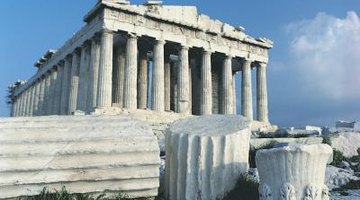Historians consider ancient Greece the cradle of modern western civilisation. The philosophy, science, language and arts of ancient Greece form the foundation of modern western thinking. The Romans incorporated much of ancient Greek culture into their society, including philosophy, laws, arts and architecture. This culture was spread through Europe by the Romans and to modern civilisation by European expansionism. The profound influence of ancient Greek architecture has endured for more than 2,000 years and is seen in buildings across modern America.
Classic Greek Orders of Architecture

The first step in recognising Greek influence in modern architecture is understanding the three classic orders of architecture: Doric, Ionic and Corinthian. The most recognisable feature of each order is the columns used in the construction of public building and temples. Most of the surviving ruins of ancient Greece are of the Doric order, which is the most basic, featuring sturdy, thick, unadorned columns set directly on a foundation. Elegant and slender Ionic columns are taller and more refined than Doric columns. Ionic columns sit on a base and include vertical fluting and a crown featuring a scroll-like design called a volute. Corinthian architecture is the most ornate of the three orders.
- The first step in recognising Greek influence in modern architecture is understanding the three classic orders of architecture: Doric, Ionic and Corinthian.
- The most recognisable feature of each order is the columns used in the construction of public building and temples.
Greek Architecture in Basic Design
Most people associate Greek architecture with grand public buildings and homes. The truth is, Greek architecture and building principles are incoporated into the most basic of buildings. In Greek architecture, the columns were set on a stone foundation and supported the building structure. At the top of the columns the crown or capital and abacus supported horizontal beams called the lintel or architrave.
In modern framed buildings, vertical timbers (columns) are attached to a sill that sits on a stone or concrete foundation. The vertical timbers are called uprights and are capped at the top (crown) to prevent splitting and to support the load of the lintel, a heavy wooden beam sitting horizontally on top of the uprights. This basic frame supports the building structure. This is just one example of how Greek architecture influences modern buildings in unseen ways.
- Most people associate Greek architecture with grand public buildings and homes.
- In modern framed buildings, vertical timbers (columns) are attached to a sill that sits on a stone or concrete foundation.
Antebellum Homes of the American South
The influence of Greek architecture is apparent on the Greek Revival-style homes of the antebellum American south. Some of these homes feature grand columns and colonnades, while others are more restrained terrace houses in the city, with small columns around the entrance. Savannah, Georgia, has many examples of these gracious homes that are now an enduring image of early 19th century southern charm and prosperity.
Government Buildings

Greek architecture projects authority, permanence and power. These qualities make it ideal for government buildings. The Supreme Court of the United States is a fine example of Corinthian architecture. The west entrance features 16 Corinthian columns under an engraved architrave. The graceful columns are topped with a crown of elaborately engraved acanthus leaves, typical of the Corinthian order.
- Greek architecture projects authority, permanence and power.
- The graceful columns are topped with a crown of elaborately engraved acanthus leaves, typical of the Corinthian order.
Monuments and Memorials

Inspired by the Parthenon, the Lincoln Memorial may be the finest example of classic Doric architecture in America. The Lincoln Memorial features thick and masculine Doric columns an impressive colonnade and unadorned architrave.
The Jefferson Memorial features graceful Ionic columns, while The General Grant National Memorial, better known as "Grant's Tomb" in New York City, incorporates both Doric and Ionic features in its design.
The Outdoor Amphitheater

Outdoor amphitheatres across America owe their existence to the ancient Greeks. Built into a hillside renowned for its legendary acoustics, the semicircular amphitheatre at Epidaurus is the prototype of the modern amphitheatre. The Hollywood Bowl in California and the Hatch Shell in Boston are familiar examples of the modern outdoor amphitheatre.
The Romans expanded upon the amphitheatre concept and built stadiums like the Colosseum which evolved into today's modern sports stadiums.
- Outdoor amphitheatres across America owe their existence to the ancient Greeks.
- The Romans expanded upon the amphitheatre concept and built stadiums like the Colosseum which evolved into today's modern sports stadiums.
Academia

Greek Architecture often is also a symbol of learning and education and is well represented on university campuses across America. Desiged by Thomas Jefferson, the Rotunda at the University of Virginia was inspired by the Pantheon of Rome. Its elaborate Corinthian columns illustrate the progression of the Greek orders through Rome and into modern America.
- Greek Architecture often is also a symbol of learning and education and is well represented on university campuses across America.
- Its elaborate Corinthian columns illustrate the progression of the Greek orders through Rome and into modern America.
The University of Michigan also boasts several examples of Greek architecture. Designed by famed architect Albert Kahn, Angell Hall is classic Doric order with sturdy columns and an engraved frieze. The Clements Library features Corinthian columns and arches.
Many other examples of Greek architecture are found on university campuses from coast to coast.
